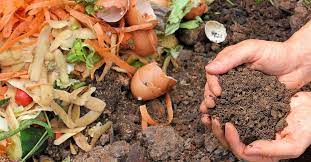Composting
COURTESY : study.com/
Compost is the soil-like product of the decomposition of organic materials. Organic material, or carbon-containing material, decays in a process called decomposition or breaking down into the most basic parts. Composting is the act of organic material decomposition. People, municipalities, and businesses compost to use the resulting product as fertilizer for soil and plants.
 |

Compost Examples
Currently, over 27% of material in landfills is comprised of food and yard waste, or the leftovers from kitchens and taking care of your lawn. Generally, most food and yard waste, like banana peels and coffee grounds, or grass clippings and leaves, can be composted. However, not all items can be composted. For example, meat and fish waste, such as bones or skin, should not be added to compost. Examples of items that can be composted include fruit and vegetable peelings, eggshells, or old sod and dry leaves.
 |
What to Compost
To build to the safest compost pile, follow these compost examples:
- Kitchen waste: peels and rinds from fruits and vegetables, eggshells, nutshells, coffee grounds, and coffee filters, tea bags, non-greasy paper towels, cardboard packaging
- Household waste: newspapers, papers, house plants, cotton or wool, hair and pet fur, cardboard, fireplace ash (wood only)
- Yard waste: hedge trimmings, dry leaves, sawdust, manure, grass clippings, woodchips, hay, and straw
What Not to Compost and Why
Not all materials can be composted. Some examples of what not to compost are:
- Coal or charcoal and the ashes: contain substances that, if released into the soil, are harmful to plants
- Pet waste (dog or cat feces, cat litter): may carry bacteria and other pathogens harmful to humans
- Dairy products: generate odor and attract pests
- Meat and fish scraps (bones and skins): generate odor and attract pests
- Grease, lard, and fat: generate odor and attract pests
- Plastic and other inorganic materials: will not decompose
- Yard trimming treated with chemicals: pesticides can harm organisms needed for composting
- Perennial weeds: will spread and grow back
What is Compost Used For?
Once all of the materials decompose, a compost pile is full of nutrient-rich humus with various uses. Compost can be used as soil, fertilizer, potting mix, mulch, and really anywhere in a garden or with crops. Aside from using it to help grow plants or as mulch, compost has many benefits:
- Divert waste from landfills: by composting food and yard waste, that waste will no longer end up in landfills
- Reduces methane in the atmosphere: when food and yard waste decomposes in landfills, it is often done in low-oxygen conditions, generating harmful methane gas. Composting is an oxygen-rich process that does not produce methane during decomposition
- Enriches and improves soil: decomposition recycles nutrients into the soil, which can make it more productive for growing
- Water conservation: healthy soil holds water better. By improving soil health, less water is needed for agriculture, an industry that places incredible demand on water supply
Examples of Composting Methods
How is composting done? Composting methods vary depending on the location, size, and scale of the composting operation. However, the general makeup, or ingredients, of the compost pile remains the same: browns, greens, water, and oxygen. For a person to create a healthy compost pile, it is important to layer in the right materials and have the right ratio of materials to provide nutrients to the pile. Compost piles also need water and oxygen to provide for organisms that aid in decomposition. Carbon-rich materials are referred to as “browns,” and nitrogen-rich materials are called “greens.” What compostable materials are browns, and what are greens?
Browns (carbon-rich materials):
- Cardboard, shredded newspaper, paper, paper towels
- Sawdust, woodchips
- Dead leaves and yard clippings
Greens (nitrogen-rich materials):
- Fruit and vegetable trimmings
- Coffee sounds and filters
- Eggshells
- Fresh yard clippings
Layering browns and greens in the proper ratio, adding water when necessary, and providing oxygen to the pile are important factors in composting. Too high a ratio of carbon-rich material, or browns, will result in a slow decomposing, very dry pile. Conversely, too high a ratio of nitrogen-rich materials (greens) will result in a slimy, wet pile with an unpleasant odor.
Along with the ratio of browns to greens, it is important to take into account the size of the items in a compost pile. If pieces of compost are too large, they will take a longer time to break down. Smaller pieces of newspaper, grass clippings, or fruit/vegetable trimmings have a higher surface area to allow for decomposition, which will help the compost mature faster. It can be helpful to shred large pieces of material, such as cardboard, newspaper, and food scraps, to hasten the decomposition process.
Overall, obtaining the correct ratio of browns to greens, size of materials, and rate of decomposition takes a bit of experimentation and testing the consistency of the compost. Ideally, the compost will have a crumbly soil-like consistency at maturity and have an earthy forest-like smell.




